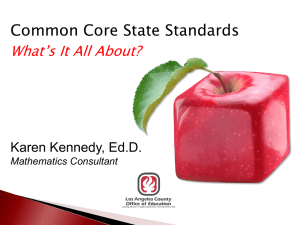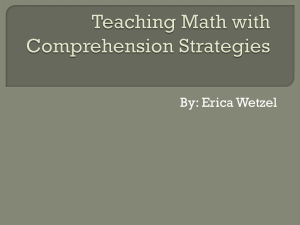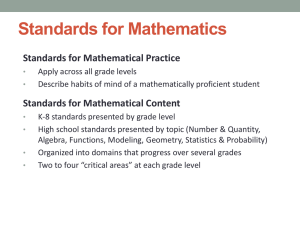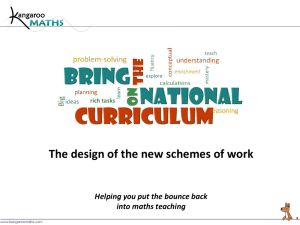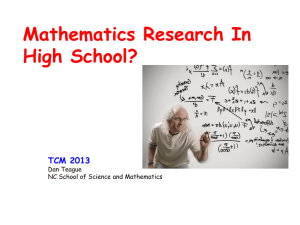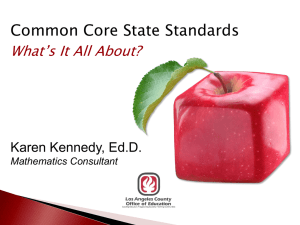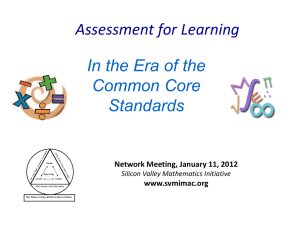Summit: realizing the potential of TI-Nspire
advertisement
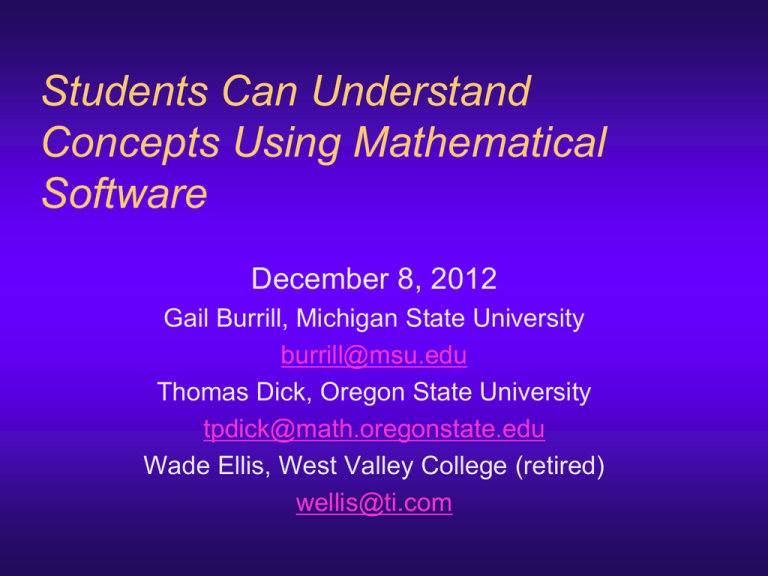
Students Can Understand Concepts Using Mathematical Software December 8, 2012 Gail Burrill, Michigan State University burrill@msu.edu Thomas Dick, Oregon State University tpdick@math.oregonstate.edu Wade Ellis, West Valley College (retired) wellis@ti.com using and choosing technology in the mathematics classroom Driving question: Does the technology afford real advantages to the teacher for…? using and choosing technology in the mathematics classroom Driving question: Does the technology afford real advantages to the teacher for…? 1) illustrating mathematical ideas, using and choosing technology in the mathematics classroom Driving question: Does the technology afford real advantages to the teacher for…? 1) illustrating mathematical ideas, 2) posing mathematical problems, using and choosing technology in the mathematics classroom Driving question: Does the technology afford real advantages to the teacher for…? 1) illustrating mathematical ideas, 2) posing mathematical problems, 3) opening opportunities for students to engage in mathematical sense making and reasoning, using and choosing technology in the mathematics classroom Driving question: Does the technology afford real advantages to the teacher for…? 1) illustrating mathematical ideas, 2) posing mathematical problems, 3) opening opportunities for students to engage in mathematical sense making and reasoning, or 4) eliciting evidence of students’ mathematical thinking. using and choosing technology in the mathematics classroom Bottom line: What leverage does technology provide to help teachers ask questions that “push” or “probe”? using and choosing technology in the mathematics classroom Bottom line: What leverage does technology provide to help teachers ask questions that “push” or “probe”? PUSH students’ mathematical thinking forward using and choosing technology in the mathematics classroom Bottom line: What leverage does technology provide to help teachers ask questions that “push” or “probe”? PUSH students’ mathematical thinking forward PROBE how students are thinking mathematically categories of technology Conveyance technologies transmit and/or receive information Conveyance technologies are not specific to mathematics. types of conveyance technology • Presentation interactive whiteboards, slide presentation (e.g., powerpoint), document cameras, projectors/monitors • Communication intranet (within classroom/school) internet (allowing extended “classroom”) • Sharing/collaboration shared documents or workspaces • Assessment/monitoring/distribution clickers, monitoring software for networks categories of technology Mathematical action technologies perform mathematical tasks and/or respond to the user’s actions in mathematically defined ways Mathematical action technologies can play the role of another actor along with the students and teacher. types of math action technology • computational/representational toolkits graphing calculators, CAS, spreadsheets • dynamic geometry environments Geometer’s Sketchpad, Cabri • Microworlds constrained environments with mathematically defined “rules of engagement” • Computer simulations parameter driven virtual enactments of physical phenomena Tools for Doing Math (technology as computational or construction task servant) vs. Tools for Developing Understanding (technology to create scenarios for insight) Technology as Tool for Doing Key issue for teachers: Helping students to become good managers of the technology – *making decisions of which tool to use and when *monitoring/interpreting results Danger: technology-based activities that overdirect step-by-step solutions to problems Bottom line: Need for rich problems as well as good questions that demand reasoning and sense making around solutions or strategies Technology as Tool for Developing Understanding Key issue for teachers: asking good questions • Predict consequence in advance of action (what would happen if…?) • Consider action that would produce a given consequence (what would make … happen?) • Conjecturing/Testing/Generalization (When…?) • Justification (Why…?) Danger: activities that simply prescribe actions and ask for recording of observations Bottom line: need good questions that demand reflection, sense making and reasoning Action-Consequence Principle Technology-based learning scenarios should Action-Consequence Principle Technology-based learning scenarios should • allow students to take deliberate, purposeful and mathematically meaningful actions Action-Consequence Principle Technology-based learning scenarios should • allow students to take deliberate, purposeful and mathematically meaningful actions • provide immediate, visual and mathematically meaningful consequences EXAMPLES from fractions to calculus Fractions: Building Understanding Research on learning algebra: Making links to the classroom 1988 NCTM Yearbook on Algebra: Common Mistakes in Algebra (Marquis, 1988) 2. 5 a x+y x+z b = (ab) = y z 7 2 2 (x+4) = x + 16 x + r = x+r y s y+s 3a-1= 10 of 22 were related to fractions 1 3a * Conceptual Knowledge: – – – – Makes connections visible, enables reasoning about the mathematics, less susceptible to common errors, less prone to forgetting. * Procedural Knowledge: – strengthens and develops understanding – allows students to concentrate on relationships rather than just on working out results NRC, 1999; 2001 A fraction Is typically thought of as: • Quotient, • Part to Whole, or • Ratio Rethinking Fractions: Based on Part 2, Fractions by H. Wu Department of Mathematics #3840 University of California, Berkeley Berkeley, CA 94720-3840 http://www.math.berkeley.edu/~wu/ Common Core State Standards A fraction 1/b is the quantity formed by 1 part when a whole is partitioned into b equal parts; a fraction a/b is the quantity formed by a parts of size 1/b. • a fraction is a number on the number line • 2. a. Represent a fraction 1/b on a number line by defining the interval from 0 to 1 as the whole and partitioning it into b equal parts. Recognize that each part has size 1/b and that the endpoint of the part based at 0 locates the number 1/b on the number line. • b. Represent a fraction a/b on a number line by marking off a lengths of 1/b from 0. Recognize that the resulting interval has size a/b and that its endpoint locates the number a/b on the number line. CCSS, 2010 CCSS: Fractions • Two fractions are equivalent (equal) if they are the same size, or the same point on a number line. • Express whole numbers as fractions, and recognize fractions that are equivalent to whole numbers. • Build fractions from unit fractions by applying /extending previous understandings of whole number operations. CCSS, 2010 What does fraction as a point on a number line buy us? • A constant way to think: k/p is k copies of 1/p - the length of the concatenation of k segments each of which has length 1/p . • Behavior similar to whole numbers: k/3 is a multiple of 1/3 Larger fraction is to the right on the number line • Connection of whole number to fractions. • One number has many names and none more important than another. • No difference between proper and improper fractions Research on learning algebra: Making links to the classroom 1988 NCTM Yearbook on Algebra: Common Mistakes in Algebra (Marquis, 1988) 2. 5 a x+y x+z b = (ab) =y z 7 2 2 (x+4) = x + 16 x + r y s = x+r y+s 3a-1= 1 3a 10 of 22 were related to fractions References Black, P. Harrison, C., Lee, C., Marshall, E., & Wiliam, D. (2004). “Working Inside the Black Box: Assessment for Learning in the Classroom,” Phi Delta Kappan, 86 (1), 9-21. Common Core State Standards Mathematics. (2010). Council of Chief State School Officers & National Governors Association. www.corestandards.org/ Marquis, J. (1988). Common mistakes in algebra.The Ideas of Algebra K-12. 1988 Yearbook. Coxford, A. (Ed). Reston, VA. National Council of Teachers of Mathematics. National Research Council (2001). Adding It Up. Kilpatrick, J., Swafford, J., & Findell, B. (Eds.) Washington DC: National Academy Press. Also available on the web at www.nap.edu. National Research Council. (1999). How People Learn: Brain, mind, experience,and school. Bransford, J. D., Brown, A. L., & Cocking, R. R. (Eds.). Washington, DC: National Academy Press. Wu, H. (2006). Fractions, Part 2. In Understanding Numbers in Elementary School Mathematics, Amer. Math. Soc., 2011.] //www.math.berkeley.edu/_wu/


